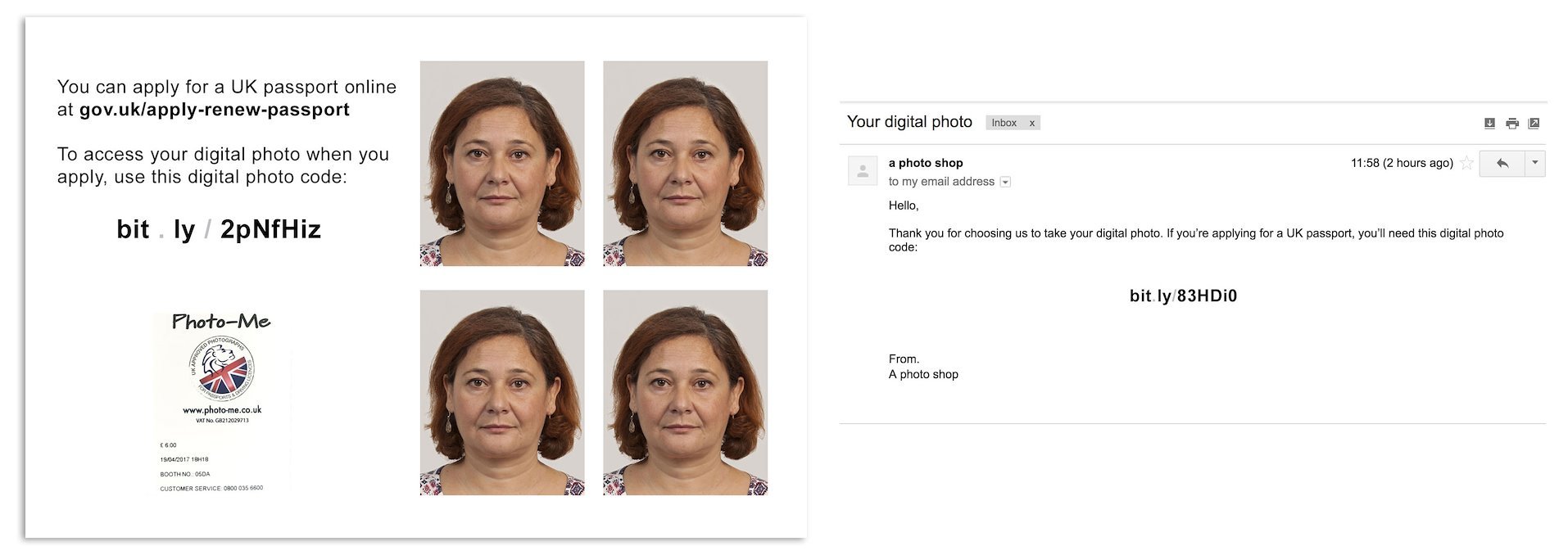Import photo booth photos directly into your passport application
The Passport Office is working on a new digital service for British citizens to apply for a passport online.
One of the biggest features of this service is being able to upload a digital photo of yourself, potentially taken with a smartphone, during the application. Paired with a concise form where you are only asked for relevant information based on the type of application, applying for a passport is now a streamlined, painless experience.
The problem.
Around 60-70% of our users had problems taking a software passable passport photo. This means that these users were not able to use the new online service for passports renewal. Our solution had a huge impact on our service, but also a game changer for the photo industry.
“Only 30% manage to get a passable photo within 3 tries, but once they do, there is a 95% conversion rate.”
We became aware of this issue while doing usability testing of various features in the service, including photo upload and dealing with rejected photos. We found people were having a difficult time taking a good enough photo for it to pass our software. Direct feedback we were receiving from users of the live service also confirmed these findings.
Starting to explore this, I created a service map and overlaid analytics on top to see where people loop and drop off the journey. What I found was that out of all eligible users that need to renew their passport, only 30% manage to get a passable photo within 3 tries. But once they do, there is a 95% conversion rate.
This was a big problem and was only going to get bigger as we are allowing more users in our public beta, with an ultimate goal of around 6 million passports a year being processed.
The users.
As all British citizens are our potential users, we usually tend to look at separating personas depending on the issue at hand, looking at the main behavioral differentiators. For this particular problem, we had 3 main personas:
P1 had a passport for a long time; has the association that to renew a passport you need to get a printed photo and a form from the Post Office.
P2 wasn’t comfortable or had the skills to take a digital photo or didn’t have the means.
P3 didn’t have the space & light to do it correctly nor a friend to help.
The process.
An obvious solution was to look at our photo guide and improve it. After numerous usability testing on our iterations, we changed the online guidance within our service and on gov.uk. We also created a video guide which was easier to follow and exposed it to the public via social media.
Another solution was to open our photo checking software to the image industry and offer help in training on how to use it to make sure a customer's photo is passable before they leave the shop.
But that was still not enough, as people don’t usually say what they need the photo for, they often use photo booths and still end up in our service with a printed photo, angry they can’t use it.
So we had to come up with a more fail-proof solution. We were wondering:
Can we get the digital photo they took in a booth or photo shop automatically, without them or the store workers needing to actively do anything?
We worked with the technical team on a solution and settled on one of a code store – to have a sequence of unique codes each provider can give or have printed on the customer receipt for them to use in our service if they need to. But this presented a problem of constantly maintaining our code store and also onboarding each new provider individually. This meant recurring costs for the project and therefore wasn’t a scalable solution.
After a few workshops, I came up with the idea that while each provider was storing the photo anyway, could they generate a unique link for us to use to pull the photo into our new service?
We created quick prototypes to mimic the service, emails, and photobooth printouts the users would receive and ran usability tests on them, iterating as we went along.
The solution.
One of our initial ideas was to offer an email to the user where they could click and automatically go on our service with the image grabbed. Less friction would be best right?
But actually, we were (pleasantly) surprised to see how the majority of our users we tested with didn’t feel comfortable clicking a link from a private company to go to a gov website where they would put their private information.
After a few iterations, we came up with the idea of a bit.ly similar solution in which each provider will offer us a shortened link in the shape of a code so users can input it easily within our service. It would be printed on the receipt, but also, more importantly on the printed photo from a photo booth.
The outcome and learnings.
The deliverable in the end stretched way outside of our service.
We worked with the photo industry to offer them support in testing if their photo passed our software and training for staff. By far the biggest outcome was a whole new feature for photo booths and shops to provide a link to a digital version of the user’s photos, which the Passport Office could access directly and securely. This is a game changer for their potential as photo industry.





